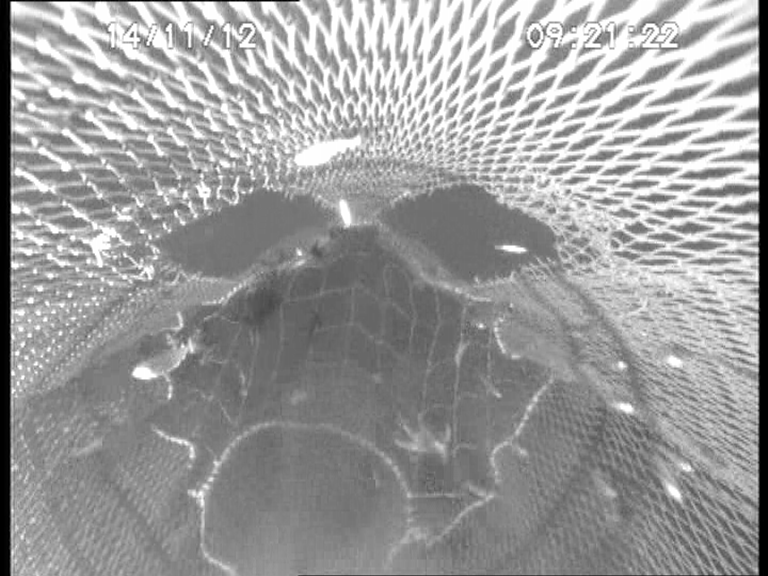Inclined Netting Grids
Summary
An inclined grid a panel of netting fitted inside a trawl set at an angle so that it guides certain species upwards and allows other species to pass through the meshes and into the cod-end. The species that are directed upwards are either directed out through an escape hole or into an upper cod-end. Several different designs have been developed to suit different fisheries.

Size selectivity
Some designs of inclined netting grid can achieve a species separation in the region of 95%. This allows the two species to be further selected with different devices. For example an inclined net grid can be used to separate fish from nephrops, with the net grid guiding the fish upwards and out of the net through an escape hole.
Alternatively they can be guided into an upper chamber while the nephrops fall through the large meshes of the net grid into a lower chamber. The lower chamber can be fitted with a smaller mesh cod-end such as 80mm diamond mesh to retain the nephrops while the upper chamber may be fitted with a larger diamond mesh cod-end to retain only the fish that are above minimum landing size. Alternatively, the upper cod-end could be fitted with a square mesh panel or a square mesh cod-end to further improve selectivity.
At different times of the year, or on different fishing grounds, the selectivity of each chamber can be easily changed by changing the secondary selective device to suit the total catch composition. If fish quotas are exhausted it is possible to leave the upper cod-end open and release all the fish just retaining the nephrops in the lower cod-end.
Other information
An inclined net grid does a similar job to an inclined rigid grid but is much easier to handle on board a fishing vessel. It has no rigid parts and will easily be hauled onto a net drum or through a power block when handling the gear. The net grid is usually made using large square or diamond mesh, the actual mesh size of the grid being developed through sea trials to suit each different fishery.
An inclined netting grid is similar to a separator trawl in the it separates species inside the trawl. The main difference is that a separator trawl works by exploiting the natural escape stimulus of certain species to swim upwards or downwards to escape the danger. An inclined grid forms a barrier that guides the more active species into a certain area of the trawl while allowing more sedentary species to fall through the mesh in the inclined panel and into a lower cod-end.
The great advantage of separating species into different areas of the trawl is that a secondary selective device that is more suitable for each individual species can be fitted into each chamber to minimise unnecessary loss of target species.
Over the years several different styles of inclined net grid have been developed and tested at sea.
The Faithlie F Cap and the Flip-Flap were developed in Scotland as a solution to the cod recovery program. The Cefas net grid in England for the nephrops fishery and the Amity net grid in Scotland again for the North Sea nephrops/fish mixed fishery. The Amity net grid has also been adopted for use in the Celtic Sea nephrops fishery. The Sep Nep cod-end was developed on similar lines for Dutch nephrops vessels.
Documents
-
Catch Comparison Trials of the Flip Flap Netting Grid Trawl
-
Catch Comparison Trials with the Faithlie Cod Avoidance Panel (FCAP)
Selection type
-
- Post-selection